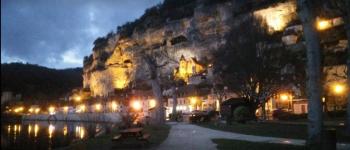
We are here on a privileged observation site of the Dordogne.
Indeed, already in the Xth century B.C., Beynac, dominated the surroundings, located that it was on a rocky promontory.
Later, it was the Gauls who watched over the river trade here and especially the import of wines from Italy.
In the twelfth century, a castle was erected to watch over the Nordic hordes who regularly went up the river and terrorized the inhabitants.
A bit of history...
Hélie de Beynac, the first known lord, implanted in 1050 a first castrum on the rock.
From the 12th century his heir, Adhémar joined one of the crusades, that of 1147.
By the marriage of Alienor of Aquitaine, with the future king of England Henri Plantagenet, Beynac became English like all Aquitaine, while paying homage to the Count of Toulouse, vassal of the king of France.
Then the new king of England, Richard I, known as "heart of a lion", took the castle in 1197.
The central tower of the castel will shelter his army, but very quickly the de Beynac family takes back the citadel, whereas Richard has just died in 1199, under the ramparts of Châlus, in Haute-Vienne.
Then it was Simon de Montfort's turn to take the fortress of Beynac. nicknamed in this troubled period "the ark of satan" by the monk Pierre des Vaux de Cernay.
A conquest made only to seize the fiefdoms paying homage to the Count of Toulouse, great protector of the Cathar religion.
During the 13th and 14th centuries, Beynac's warlike power enabled him to increase his influence in the region.
Pons, Jean-Bertrand, Geoffroy, all lords of Beynac will participate in the fight against the English while allowing this seigniorial family to extend its territory as far as the Vézère.
In 1337, the Hundred Years' War began with its procession of guerrillas and skirmishes, taking and recapturing strongholds.
Finally, in 1453, after a final victory of the French army over the English troops at Castillon near Bordeaux, the valley regained peace. The landscape was then only ruined...
The castel was embellished during the Renaissance, the rampart around the village opened, allowing the construction of houses at the foot of the river.
But the religious wars brought new suffering to the population in this 16th century.
Beynac, not hiding his belonging to the reformed religion, will suffer from it, the parish church of Saint-Jacques, in the center of the village, being destroyed and burned.
At the beginning of the 17th century, the king decided to recognize the land of Beynac as a Marquisate to thank the family for their commitment to the crown of France.
Beynac joined the "Fronde" and the last Protestant Marquis, Isaac de Beynac, died in 1687.
New taxes and charges and very harsh winters like those of 1709 and 1710 contributed to a generalized uprising in the countryside. Those of Beynac mingled with the rebellious peasants of Saint-Vincent and Bèzenac.
They will be nearly five thousand to cross the Dordogne at Castelnaud, to march on Sarlat.
The repression will be terrible, Beynac will be cut in two: those of the fortress and those of the village...
In 1761, the last heiress of the Lords and Barons of Beynac, Marie-Claude, married the young Marquis Christophe de Beaumont on the morning of March 10.
After eight centuries of history, the Beynac line died out with her in 1811, leaving Beynac and its castle as a testimony.
Wanted site for film shooting
The castle has been the setting for the shooting of many films:
André Hunebelle's Capitan, in 196012
Gaston Phébus in 1978
She sees dwarves everywhere! by Jean-Claude Sussfeld, in 1982
Bertrand Tavernier's La Fille de d'Artagnan13 in 1994
Les Couloirs du temps : Les Visiteurs 2 by Jean-Marie Poiré, filmed around March 1997 at the Château de Beynac
Forever After: A Cinderella Story (1998)
Joan of Arc by Luc Besson, in 1999
The Chocolate of Lasse Hallström, in 2000
Fanfan la Tulipe by Gérard Krawczyk, in 2003
Ridley Scott's The Last Duel in 2020
The visit...
The castle consists of a square Romanesque keep attached to a dwelling. It was classified as a historical monument in 1944.
You will discover during your visit, the guards' room attached to the keep, the Perigord states room which was used as a meeting room for the baronies (Bourdeille, Biron, Beynac and Mareuille), the terrace of the spur with its breathtaking view of the Dordogne valley, the kitchens with their imposing chimney and the barbican an advanced fortification intended to protect the main entrance of the fortress and to slow down the enemies.
Château Beynac
Route du château,
24220 Beynac-et-Cazenac
Tél. : 05 53 29 50 40
reservation@chateau-beynac.com
Translated with www.DeepL.com/Translator
(free version)





